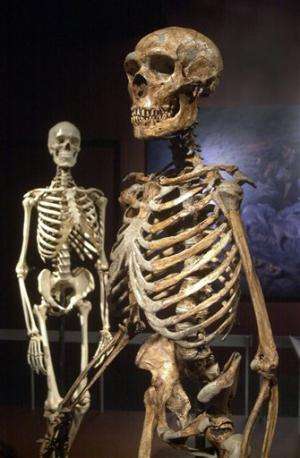The last Neanderthals had passed by southern Iberia quite earlier than previously thought. The new data casts doubt on the theory that sapiens and Neanderthals coexisted in Iberia during the Upper Pleistocene. Credit: Neanderthal Museum (Mettmann, Germany)
Theories about when the last Neanderthals walked the Earth may have to be revised, according to a study that suggests they became extinct in their last refuge in Spain much earlier than previously thought.
Previous dating of bone fossils found at Neanderthal sites in the region put the youngest at about 35,000 years.
But researchers from Australia and Europe re-examined the bones using an improved method to filter out contamination and concluded that the remains are about 50,000 years old.
If true, the study, casts doubt on the idea that modern humans and Neanderthals co-existed—and possibly even interbred—for millennia, because humans aren't believed to have settled in the region until 42,000 years ago.
"The results of our study suggest that there are major problems with the dating of the last Neanderthals in modern-day Spain," said Thomas Higham, deputy director of the Radiocarbon Accelerator Unit at Oxford University in England. "It is unlikely that Neanderthals survived any later in this area than they did elsewhere in mainland Europe."
The study, which was published Monday by the journal Proceedings of the National Academy of Sciences, doesn't completely exclude the possibility that Neanderthals survived until 35,000 years ago. The problem is that the warm climate on the Iberian peninsula quickly degrades a key protein used in so-called radiocarbon dating.
The researchers were only able to test bones from two of the 11 known Neanderthal sites in Spain. They were subjected to a new method called "ultrafiltration." This removes more recent carbon molecules that have contaminated the bones and made them appear younger than they actually are.
Such techniques often lead to older radiocarbon dates, said, Chris Stringer, a senior research fellow at Britain's Natural History Museum. "Science moves on and technology moves on," he said.
Stringer, who was not involved in the study, said the new techniques should now be applied to other sites in Spain. "Until this is done, there must be a significant question mark over the possible late survival of Neanderthals in the region."
In this Jan. 8, 2003 file photo, a reconstructed Neanderthal skeleton, right, and a modern human version of a skeleton are on display at the Museum of Natural History in New York. Theories about when the last Neanderthals walked the Earth may have to be revised, according to a study published Monday, Feb. 4, 2013 that suggests they became extinct in their last refuge in Spain much earlier than previously thought. (AP Photo/Frank Franklin II)
If the remains from the other sites, too, turn out to be older, any encounter between Neanderthals and humans would have to have taken place earlier than previously thought, he said.
"Evidence from Britain, Belgium, France, Germany and Italy is increasingly pointing to a modern human presence before 40,000 years ago," said Stringer. "The new chronology suggests that any interaction between the last Neanderthals and the earliest moderns in Europe will similarly move before, rather than after, 40,000 years."
There is also the chance that Neanderthals survived longer in other corners of Europe, said Rachel E. Wood of the Australian National University in Canberra, a co-author of the study.
"There are some other possible areas that may have also acted as a refuge for the species, such as the Caucasus, but the 'young' radiocarbon dates in these areas have also found to be problematic," she said.
More information: Rachel E. Wood, Cecilio Barroso-Ruíz, Miguel Caparrós, Jesús F. Jordá Pardo, Bertila Galván Santos and Thomas F. G. Higham. "Radiocarbon dating casts doubt on the late chronology of the Middle to Upper Palaeolithic transition in southern Iberia", Proceedings of the National Academy of Sciences (PNAS). 04-02-2013. DOI: 10.1073/pnas.1207656110
Journal information: Proceedings of the National Academy of Sciences
Copyright 2013 The Associated Press. All rights reserved. This material may not be published, broadcast, rewritten or redistributed.

























